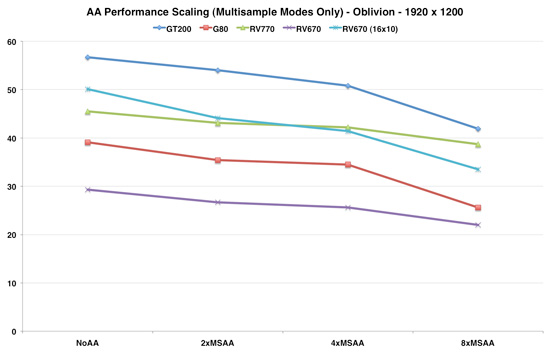The Radeon HD 4850 & 4870: AMD Wins at $199 and $299
by Anand Lal Shimpi & Derek Wilson on June 25, 2008 12:00 AM EST- Posted in
- GPUs
Fixing AMD's Poor AA Performance
Now that we have a new architecture from AMD with improved AA performance, it's time again to look at a comparison of all the different AA modes these cards offer. No new modes have been introduced since the R600 and G80 reviews, but AMD has completely rebuilt their ROPs with special attention to hardware based AA resolve. In R600, hardware resolve wasn't much faster than shader based resolve, but this time around, AA runs blazingly fast whether its on the dedicated resolve hardware or on the shader hardware (since their is so much more shader hardware now even shader based resolve gets a giant boost).
The first thing we will want to look at are the MSAA modes. These are the modes we absolutely recommend for use with AMD hardware as all their other filters essentially low-pass filter the entire image by blending in neighboring subpixels. In any case, the results are very impressive for RV770.
The RV670 at 19x12 was limited in some way other than AA (it really couldn't keep up), but at 16x10 we can get a better idea of relative impact of AA. And clearly the RV770 quite improves fall off with increasing AA levels over the previous generation. One special thing to note is that the RV770 does fall off very gracefully to 8xAA. Since the RV670, G80 and GT200 all have sharp drops in performance when moving up from 4xAA to 8xAA, the RV770 really shines here. In fact, the few tests we did with 8xAA paints the 4870 in a much better light relative to the GTX 280. Remember from our earlier architecture discussion that Oblivion is the game where the GT200 had the largest performance advantage over RV770.
While 8xAA performance is all well and good, the image quality difference is just not enough for us to recommend enabling it over increasing resolution (or better yet, pixel density on LCD panels -- hello display makers). For those with panels that don't go over 1280x1024, it would be better to spend the extra money on a large panel than a $300 graphics card. The application where we see 8xAA making the most sense is on 50+ HDTVs used as computer monitors where the pixels are just plain huge. For the majority of desktop users though 4xAA is where it's at.
We did test the performance of all the other modes as well. NVIDIA's CSAA modes are quite good (they actually improve image quality rather than degrade it), but again, stay away from anything but AMD's "box" filtered AA.
The RV770 actually shows a bigger performance hit from enabling their tent filters than RV670. This is likely because the filters are run on shader hardware in both cases while RV770 has faster hardware resolve that can be used for normal AA resolve. If RV670 resolves "box" filtered AA on the shader as well this would explain the flatter performance in that case. Even more so than the image quality question, the fact that they perform lower really should be the nail in the coffin for AMD's tent filter garbage.











215 Comments
View All Comments
paydirt - Wednesday, June 25, 2008 - link
You guys are reading into things WAY too much. Readers understand that just because something is a top performer (right now), doesn't mean that is the appropriate solution for them. Do you honestly think readers are retards and are going to plunk down $1300 for an SLI setup?! Let's leave the uber-rich out of this, get real.So a reader reads the reviews, goes to a shopping site and puts two of these cards in his basket, realizes "woah, hey this is $1300, no way. OK what are my other choices?"
This review doesn't tell people what to do. It's factual. You (the AMD fanbois) are the ones being biased.
Jovec - Wednesday, June 25, 2008 - link
"This fact clearly sets the 4870 in a performance class beyond its price."Or maybe the Nvidia card is priced above its performance class?
DerekWilson - Wednesday, June 25, 2008 - link
it could be both :-)Clauzii - Wednesday, June 25, 2008 - link
I think You are right. nVidia had a little too long by themselves, setting prices as seen fit. Now that AMD/ATI are harvesting the fruits of the merger, overcomming the TLB-bug, financial matters (?), etc. etc. it seems the HD48xx series is right where they needed it.This is bound to be a success for them, with so much (tamable) raw power for the price asked.
Clauzii - Wednesday, June 25, 2008 - link
Yeah! Nice to see competition get into the game again.gigahertz20 - Wednesday, June 25, 2008 - link
Page 21 is labeled "Power Consumption, Heat and Noise" in the drop down page box, but it only lists power consumption figures. What about the heat and noise? Is it loud, quiet? What did the temperatures measure at idle and load?abzillah1 - Wednesday, June 25, 2008 - link
I am in love0g1 - Wednesday, June 25, 2008 - link
"NVIDIA's architecture prefers tons of simple threads (one thread per SP) while AMD's architecture wants instruction heavy threads (since it can work on five instructions from a single thread at once). "Yeah, they both have 10 threads but nV's threads have 24 SP's, AMD's 80 SP's. But the performance will probably be similar because both thread arbiters run about the same speed and nv's SP's run about double the speed, effectively making 48SP's (and in some special cases 96).
ChronoReverse - Wednesday, June 25, 2008 - link
Perhaps it's drivers but if AMD intends for the 4870x2 to compete as the "Fastest Card", they better fix their drivers ASAP.FITCamaro - Wednesday, June 25, 2008 - link
With a few driver revisions it will likely improve.